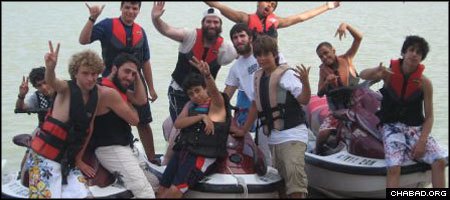Those long sultry days are back, and with school out for the season, millions of American children are fully enmeshed in summer fun. But aside from the outings to the arcade or neighborhood pool, more and more, children and parents are rediscovering camp – that quintessential youth activity of yesteryear – to be just the place to spend the summer.
According to the American Camp Association, which tracks some 12,000 summer camps throughout the United States, recent years have seen a sizable increase in camp enrollment. The organization’s 2006 Camper Enrollment Survey demonstrated a four to 10 percent surge in attendance at a full 40 percent of established institutions.
Further attesting to the growth is Camp Gan Israel, a worldwide network of Chabad-Lubavitch day camps and sleep-away camps that began with a center in Ellenville, N.Y., in 1956. Today, more than 1,000 Gan Israel branches operate worldwide, with close to 500 in the United States. The majority offer day-camp programs in which campers return home after a full day of activity, but 55 operate traditional sleep-away camps tucked away in natural settings.
But what sets Gan Israel apart, say staff members and counselors, is its focus on strengthening the Jewish identities of its campers. Named after Rabbi Israel Baal Shem Tov, the 17th-century founder of the Chasidic movement, Gan Israel camps embrace the openness and dedication to children that was a hallmark of his life. The camp system was founded by the Rebbe, Rabbi Menachem M. Schneerson, of righteous memory, whose care for children and devotion to their education is legendary.
In a public address on the benefits of summer camp, the Rebbe told parents that Gan Israel provides “a healthy summer, for it makes children healthier physically and spiritually.”
Illustrative of that goal are two particular camps that opened their gates in the past few years: Camp Gan Israel of Running Springs, Calif., and Camp Gan Israel of South Padre Island, Texas.
Atop a mesa 6,500 feet above sea level in the S. Bernardino Mountain Range 80 miles east of Los Angeles sits the Running Springs site, home to a sleep-away camp currently in its third season. Two separate one-month sessions for boys and girls offer “a place of belonging where children can develop new skills, build meaningful friendships, enjoy outdoor adventure and deepen their love of Judaism,” said Rabbi Gershon Sandler, the camp’s director.
Spirituality in the Wilderness
Activities in Running Springs include rope courses, team sports, theater productions, wilderness survival training and field trips amidst lush surroundings and crisp mountain air.
“The idea of our program is to immerse children in a holy atmosphere 24/7,” explained Sandler. “Everything we do up here is incorporated with Judaism. Children come away from home to our pristine national forest, where there’s no distraction from the Internet. Here, they can just appreciate the wonders of G‑d.”
“I focus on teaching Jewish art,” said Mushka Lightstone, who serves as the art director and camp photographer for the girls’ program. “Many of our campers come from homes that until now might not have focused too much on Jewish practice. Here, we make artistic objects from daily Jewish life, like Shabbat candlesticks, challah covers, and charity boxes.
“One activity allows the girls to make leather bracelets etched with the Hebrew word for love, ahava.”
As with other Gan Israel camps, said counselor Sharon Weiss, lessons are reinforced through the example of counselors, who in the older bunks may not be that much older from the campers.
“We demonstrate that Shabbat is fun,” offered Weiss. “One camper even started washing his hands in the morning,” a practice delineated in the Code of Jewish Law, “because he saw me doing it.”
More than 1,500 miles away on the western coast of the Gulf of Mexico sits the South Padre Island facility. A twist on the traditional camping model, the Camp Gan Israel there is practically devoted to water sports. Campers go on regular banana-boat excursions, deep-sea fish, and compete for the most-creative sandcastle design.
Rabbi Asher Hecht, the camp’s director, said that he came up with the idea for the camp when he visited the area as a traveling rabbinical student.
“Kids are looking for a fun time,” offered Hecht. “Here, we don’t just want to be another camp.”
In one camper’s words, “we pretty much do anything that you can do on water.”
A full regimen of jet-skiing, wind-surfing, surfing, complements a Judaic curriculum similar to that in Running Springs. Differences abound, however: In Texas, campers on fishing expeditions learn how to identify a kosher fish by the presence of fins and scales.
“Every kid finds where he can grow,” said Menachem Posner, a past counselor at the Texas camp. “Some learn the basic prayers for the very first time. For some, it’s all about being comfortable among other Jewish people.”




Start a Discussion